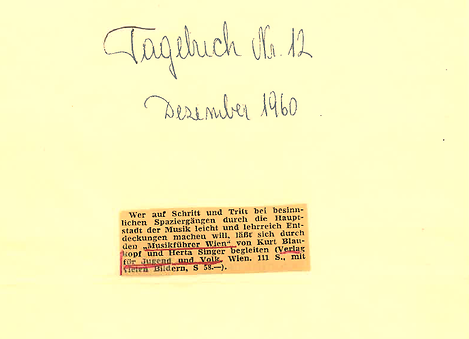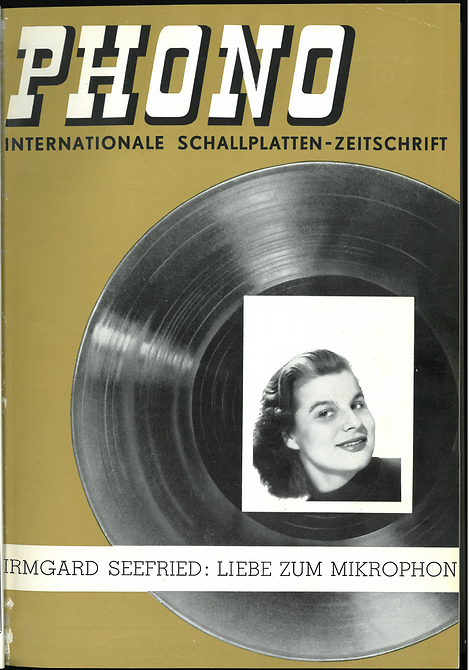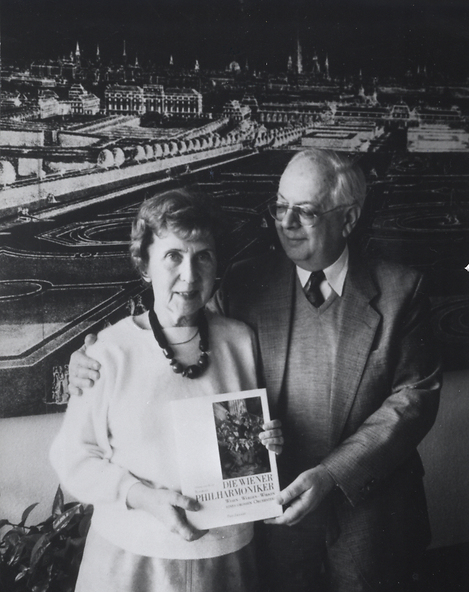
Shared scientific interests and research foci
One of the pivotal research questions the project concerns itself with is targeted at scientific interests that were shared by both Herta and Kurt Blaukopf and, consequently, topics they both addressed in their scholarly work. Their collaborative phases as well as shared research foci can be reconstructed as follows (cf. Reitsamer 2019, Chaker/Viehböck [forthcoming]):
Journalistic efforts in arts and culture: Herta Singer and Kurt Blaukopf first met in 1948 while working on the editorial staff of the Austrian newspaper “Der Abend”. Although both of them were affiliated with the arts and leisure section, they specialised in slightly differing sub-topics: While Kurt Blaukopf mainly operated as a music critic, Herta Singer would additionally discuss theatre productions and literary texts, utilising her doctorate in German Philology. However, both of them shared a deep interest in the cultural and historical development of the city of Vienna that caused their research foci to align for the first time: In 1957 they published their first co-authored book, entitled Musikführer Wien: Entdeckungsreise in die Hauptstadt der Musik [Music guide to Vienna: voyage into the capital of music].
Architectural acoustics: Around the time of their wedding, both Herta and Kurt Blaukopf started to take an interest in acoustic phenomena, striving to ascertain how exactly the architectural design of spaces impacts the style of speech or music performed within them. However, despite this topic being of interest to both scholars, they again chose to specialise in different aspects for their individual publications. In an article from 1958 Herta Blaukopf tried, for instance, to reconstruct the acoustical conditions of the old Burgtheater in Vienna for plays as well as musical performances. Kurt Blaukopf also published on historical changes of stage spaces and venues, but focused on the latest developments in recording technology.
Life and work of Gustav Mahler: The scientific investigation and exploration of Gustav Mahler’s life and work constituted an extensive part of Herta and Kurt Blaukopf’s scholarly efforts. Nearly from the beginning, they worked on this subject in collaboration, unearthing and collecting long-lost archival material, documents and records, publishing their insights and, thereby, contributing to the rising popularity of Gustav Mahler’s music from the late 1960s onwards. However, particularly Herta Blaukopf developed an intense, life-long interest in the composer's life and work and managed to establish herself as an independent expert within the international scientific community by the beginning of the 1980s.
- Excerpts from a radio interview with Herta Blaukopf broadcast by the station Ö1, 19.4.1983
Researching the Vienna Philharmonic and beyond: Throughout the 1980s, the Vienna Philharmonic tasked Herta and Kurt Blaukopf with a publication featuring the renowned orchestra. In their first edition from 1986 as well as in the revised and extended one from 1992, the couple’s aim was not only to portray the orchestra in detail, but to advance the entire field of orchestra research. In retrospect, Herta Blaukopf (2000: 15) characterised this collaborative phase as the “best and most fruitful” one [“schönste und fruchtbarste”].
“Scientific Worldview and Art”: With the beginning of the 1990s, Herta and Kurt Blaukopf became members of the Institute Vienna Circle, which today belongs to the University of Vienna. With Kurt Blaukopf presiding over the institute’s main project “Scientific Worldview and Art” [“Wissenschaftliche Weltauffassung und Kunst”] until his death in 1999, the couple worked alongside other intellectuals, exploring Austrian theories of art and science.
Sources
Blaukopf, Herta: Aus einer Schreibwerkstatt: Leben und Arbeiten mit Kurt Blaukopf, in: Seiler, Martin/Stadler, Friedrich (Hg.): Kunst, Kunsttheorie und Kunstforschung im wissenschaftlichen Diskurs: in memoriam Kurt Blaukopf (1914-1999), Wien 2000, S. 13-19.
Blaukopf, Herta/Blaukopf, Kurt: Die Wiener Philharmoniker. Wesen, Werden und Wirken eines großen Orchesters, Wien 1986.
Blaukopf, Herta/Blaukopf, Kurt: Die Wiener Philharmoniker. Welt des Orchesters –Orchester der Welt, Wien 1992.
Chaker, Sarah/Viehböck, Raphaela: „Miteinander gearbeitet haben wir, seit wir einander kannten“. Zur wissenschaftlichen Partner*innenschaft von Herta und Kurt Blaukopf, in Fornoff-Petrowski, Christine/Bagge, Maren/Ricke, Anna/Rode-Breymann, Susanne (Hg.): (Wahl-)Verwandtschaften: Gemeinschaftliches kulturelles Handeln. Böhlau Verlag (forthcoming).
Reitsamer, Rosa: Presentation given at the first award ceremony for the Herta and Kurt Blaukopf Award for outstanding dissertations at the mdw – University of Music and Performing Arts Vienna, 16 December 2019.
Singer, Herta: Materialien zur Rekonstruktion akustischer Charakteristiken (Das alte Burgtheater in Wien). In: Gravesaner Blätter, 4. Jg. (1958), Heft 11/12, 87-92.
Singer, Herta/Blaukopf, Kurt: Musikführer Wien. Entdeckungsreise in die Hauptstadt der Musik, Teufen 1957.


